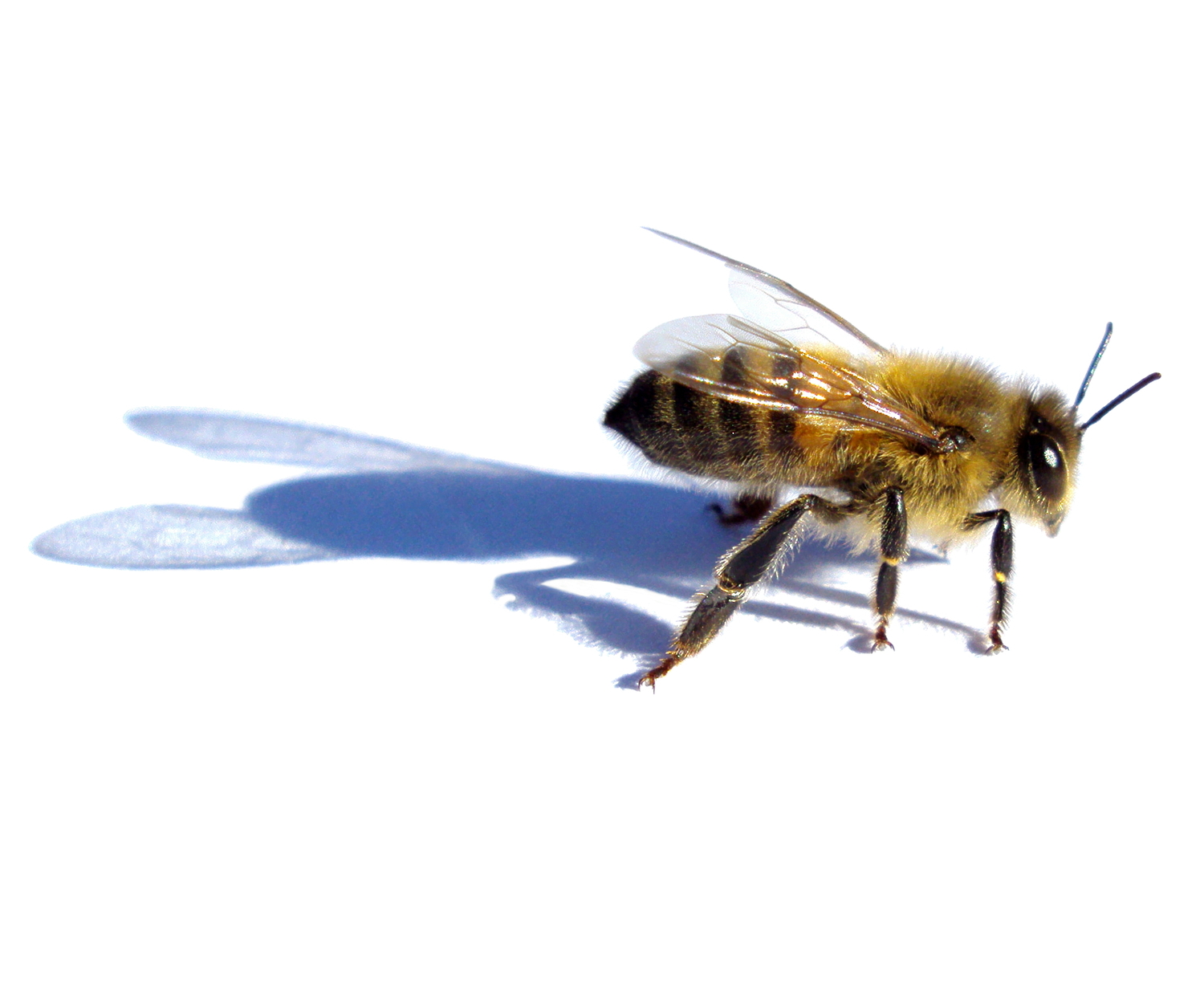Beekeepers' Institute Programming and Schematics
Beekeepers in South East England are more numerous than beekeeping populations in other countries. And why is this? Beekeepers in Southeast England have day jobs. By maintaining a day job, these beekeepers can devote themselves to their income by day and to their bees by night and on the weekends. Many beekeepers take personal time off in order to improve the lot of their bees.
Gven this level of passion and devotion, Londoners who are beekeepers have very specific requirements for their beekeepers Institute. Owing to the fact that many beekeepers time is so scarce, many beekeepers elect to stay at the Institute during week long periods of personal time off from their day jobs in order to make a meaningful effort of maintaining their bees.
Skep Maker's Retractable Shelter- a place where straw matts may be woven and dried- out of the rain.
One of the programmatic functions of the Beekeeper's Institute is the creation of an indoor/ outdoor space that will serve as an activity space that can provide shelter from the rain at times, and provide access to sky for the bees that may be part of that activity when the weather is fair. This space became formally known as "The Farmyard" in the proposal. The Farmyards occur as stepped thresholds that can be covered with retractable canvas aprons during the winter months to store dry goods such as Skeps and wooden bee boxes and straw material used by the SkepMakers to make Skeps. There is also a thought that these farmyards can serve as shelter for bees in the winter and that these spaces will provide for protection against parasites and predators by maintaining a clear floor surface that is impregnable to intruders. Each BeeMaster has his / her own thoughts on winter care for their bees.
The activity of making skeps is a historical activity that uses straw-dried in vertical matts and then removed from the matts once dried. The dry straw is then woven into basket-like vessels for the introduction of a bee colony. This method of keeping bees is used by beekeepers who want a simple home for their bees and don't plan on extracting the honey from the bees. Often, these skeps are colonies that are used to maintain a more hermetically sealed enclosure that is more disease and parasite resistant place to build a population of bees prior to removal of the queen for queen rearing or for consuming honey on comb, which retains many of the natural antibiotics that bees build in to the hexagonal homes for their young.
The Heart of The Beekeepers Institute- The BeeMaster's Cabins (Farmhouses)
During Evenings and Weekends, Beekeepers take up residence in their cabins where their allotment of bee hives is cared for either in the farm yard, on the plateau or on the teaching platforms of any one of a number of live bee demonstration classrooms. The BeeMaster's Cabins are provided by the Institute for reservations over a period of time determined by the bee keeper's proposal. Most beekeepers stay in the cabins one night per week. If they have a more involved activity to accomplish, they may stay as long as one week. Two of the cabins are dedicated to resident scientists who have parallel foci- one is botanical and the other is entomological.
The BeeMaster's Cabins and the associated Farmyards serve as teaching centers and demonstrations for the public, workshops with tools for the individual BeeMasters where they may assemble their bee boxes and frames, and as a place where the SkepMakers may assemble their skeps out of the rain.
Auto Parts Distributor by Day, Entomologist by Evenings and weekends:
The entomologists who specialize in Honey Bees have a family auto parts business as their income and also are PhD Scientists by degree. Their research relates to the phenomenon of communication between bees. In order to research this, a completely dark room the size of a small garage is required to simulate the interior of a bee hive/ bee colony. It is in this space that a colony of bees are temporarily housed in a space that is large enough to contain the entomologist and his equipment as well as the bees.
The space rendered in the sketch which resembles a large sleeping bag inside a garage is the concept for this space where the entomologist has electronic equipment that simulates the dance of the honey bee. The entomologist's robotic, electronic bee performs a similar dance to the honey bee dance and communicates the distance, direction and type of forage of the location of food that is of interest to the bees. The entomologist then captures video of the same (marked) bees arriving at the where they are rewarded by the presence of the same food (nectar and pollen). There are other experiments that the entomologist performs in this space which evolved in the design of the Beekeepers Institute into the "Farmyard" which is a space that can be covered with canvas to provide shelter from the daylight and rain.
The Farmyard is visible in the plan and sectional views of the 1:50 Model photos at right. The Farmyard is essentially a multi-purpose space that provides the following purposes at a minimum; 1) Bee Hive Winter-proof Locations, 2) Instruction Classroom, 3) Entomologist Laboratory, 4) Nuke Zone- Space for building small young hives, 5) Temporary Outdoor Storage, 6) Decanting Space for BeeMaster's Cabin, 7) Access from the Institute to the Plateau.
The construction of this Farmyard space uses Core-Ten Sheetpile, Chemical Railroad Sleeper Timber Terracing, Galvanized Pipe Guardrail, Ferro-Cement Pavement Lights, Light Gauge Galvanized Corrugated Sheet Metal, Aluminum Framing and Glass. These materials are detailed in such a way as to be consistent with the rest of the design of the Institute which employs all of these materials to enclose spaces that are applicable to other activities in the Program of the Beekeeper's Institute.
Stationers by Day, Beekeeper's Institute Slide Librarian by Evenings and Weekends:
One of the unexpected by-products of the Beekeepers joint efforts is the creation of over one hundred thousand photographic slides (pre-digital age) that require storage and recovery from a library based in the grounds of the Institute. This space is frequented by members of the institute for lectures, as well as research. The activity of scanning these slides for electronic storage is also common in the slide library as is maintenance of the institute's web server.
The Slide Library is one of several spaces in the Beekeeper's Institute that does not require protective clothing in order to access the many drawers of slides in it's casework. The space has a significant amount of natural light and is attached to the Institute's Book Library. It is a double height space with cases full of catalogues that identify the slide location and content. There are views out of this double height space that see out to the park and over the cascade of roofs which increasingly turn themselves up as the roofs become part of the live bee activities and the eaves slope up so as to prevent the bees from getting trapped.
Q: Why do the roofs of the working bee buildings slope up?
A: Bees get trapped under down-turned eaves. This is a common confusion for a bee who believes that the only solution to entrapment is to fly up. Hence, the Institute's buildings, which become more alive with bees as the Institute continues further into the Park- these outpost buildings' roofs become more inverted as a result. This is visible as a curious feature of the design of the institute and also happens to coincide with the increasingly unruly topography of the park which is the result of the landfill component of the planning and site design of the Park's re-design. While standing on either of the two Plateaus, this changing geometry of the Institute's Roofs is evocative of the beating of wings and is also caused by the beating of wings on a much smaller scale.
The long cantilevers that the roofs extend over the teaching spaces are two-directional sandwiches of corrugated, galvanized, sheet metal that have a core of spray-on insulation identical to that of the exterior wall construction.
Q: Why don't the buildings just sit on top of the landfill? Why are they clipped onto the side of the landfill mound?
A: The creation of "rules" that govern the introduction of new buildings in the park involve using new construction to help create park thresholds. These thresholds create more interaction with people entering and leaving the park. The buildings themselves also become more a part of the land at the margins of the park, allowing the park to be about the landscape rather than just a "greenfield site" for architects to reduce the park to a sub-urban subdivision. By contributing to the overall effort of landfill retainage and slope stabilization, the new buildings allow the open spaces of the park be dedicated to temporary structures such as beehives on the plateaus and other natural landscape features such as trees and meadows. There is also a historical precedent and rational for treating the debris removal as did prior generations.
Commuter Train Driver by Day, Beekeeping Lecturer during evenings and weekends- The Lecture Hall is a space that allows observation of Live Bee Demonstrations:
The Lecture Hall is a multipurpose space located on an elevated level just inside the entrance to the Institute and it has an observation portal that allows for visual instruction of live bee demonstrations being performed by instructors with an audio link to speakers inside the lecture hall. This observation portal is hermetically sealed from the environment outside and provides views of the park in the distance, beyond the plateau where the instruction observation takes place.
The lecturer also may depend on a multi-media presentation and darken the room for such presentations. The botanist, who lectures on species of plants that would not exist were it not for bee pollination presents plants in realtime in the lecture hall and maintains them in potted plantings on the plateau adjoining the Farmyards.
BeeMaster's Shed- "A busy Farmhouse", a place where beekeepers can compare notes.
Activities can involve the use of power tools including table saws. Therefore, three phase electrical service is available at each of the farm houses. The only water supply available at each house is for potable water. Showering and sanitary facilities are available in the main part of the Institute in the locker room. The farmhouse is Spartan in nature, each has food preparation and a study table in the sleep space on the upper-level. Members of the public on the plateau can walk over to the farm yard areas and witness the activities going on below from the guard rail. Naturally, the presence of many honeybees will be a deterrent to people with allergies. Discrete signage at the periphery and the entrances to the plateau will warn people of the presence of bees similar to keep off the grass signs. It is possible to descend down into the farmyard from the plateau on retractable stairs not shown in the model. The guard rail at that section of the retaining wall is also removable.
NewsAgent by day, Pollen Collector and Bee By-Products on Evenings and Weekends.
Rajiv works at Brixton Tube Station at a NewsAgent that he owns. At night, he often rides the No. 3 Bus to Crystal Palace where he collects pollen from bee hives at the Beekeepers Institute. Pollen is considered by many eastern cultures to be a sacred substance. Scientists have discovered that pollen contains antibiotic properties. In addition to pollen, royal jelly is also considered to be a substance that contains wellness properties. In order to extract Holland and royal jelly and beeswax from the beehives, Rajiv has to work very hard in cooperation with the other beekeepers. His harvest has to be stored in food grade containers in a dry and cool environment. The sketch shown to right shows vaults that are properly waterproofed with a vapor barrier and a waterproof membrane that are kept at a naturally cool temperature thanks to being below grade. The honey bee by-products are packaged for sale at the Bee Products retail shop shown on the plan above.
The Plateau- single-story buildings protrude above the level of the plateau.
In all cases, single-story extensions of each institutional building rise above the level of the plateau and present a subdued elevation. The presence of guard rails at each farmyard also define the area at the periphery of the plateau. In the case of the farmhouse, there are two doors. One door leads into the sleeping space on the upper level and the other door leads to a stair which goes down to the lower level. These doors are protected from the weather by a continuation of the roof visor. There is a skylight in each roof. In addition, there is a pavement light at the threshold to each pair of doors that allows light into the lower level. Rainwater is collected and scuppered off of the inverted eaves and recycled into rainwater drums.
Enlarged Sketches Below:

Basic Programming of The Bromely Beekeeper's Institute at Crystal Palace Park
The Beekeepers Institute consists of many functions and spaces, some multi-purpose and others dedicated to the study of, exhibits for, discussion and demonstration of bees and bee products, including apiculture and agriculture that depends on the activity of bees.

Railwaymen by Day/ SkepMakers by Evenings & Weekends- "The Farmyard" is for farming bees year round.
In England, one honorable occupation is the construction and care of the railways in the realm. The boundary created by railways often results in thick natural buffers that become overgrown with old growth trees and are secluded places where bees are prone to swarm and grow new colonies. Railwaymen have been known to reconnoiter with the bee swarms, facilitate a new home for them and to do that using a bee hive known as a Skep.

Beekeeper's House & Farmyard- A utilitarian cottage with upturned roof canopies that free the bees from getting trapped in the eaves...
In order to allow the Beekeeper to sleep and study and prepare food in her spare time, she must climb up to the horizon level room at the plateau where a manicured landscape forms her front yard. Her front door opens into a skylit space that egresses stray bees through operable glazing. During her workday, there are members of the public who eagerly watch her work with the bees, taming them and teasing out of their hordes a specimen of honey, a queen to be reared, a crop of pollen to be processed, a dose of royal jelly.

Resident Entomologist's Laboratory, Study and Bee Communications Lab- ...his day job is selling auto parts.
Auto Parts Distributor by Day, Entomologist by Evenings and weekends, he communicates with the bees (as seen on National Geographic).

Section through the landfill upon which the beekeeper's house is anchored using sheet pile retaining walls. Crowds of people gather around the balustrade to watch.
Two hundred years of debris lies beneath the timber floor of the farmyard. The sand, the rip rap from the demolished exhibition buildings, the expansive clay, the excavation of the early Victorian landscaper, and, the London Basin layer itself. Above grade, the ephemeral activity of beekeeping, and the boxes of bees themselves are an attempt to understand why the bees are becoming extinct.

Stationers by day, Slide Librarians by Evenings and Weekends- a critical activity space at the Beekeepers Institute.
These volunteers, who staff their stationary store by day- also provide librarian expertise at the Beekeeper's Institute during the weekend and evenings. Beekeepers are allowed to trawl through the drawers of slides and borrow images of bees, their parasites and their habitat in order to confer with lecture hall packed crowds as to what may be causing colony collapse disorder and quite possibly their extinction.

View of the Beekeeper's Institute from the private park side entrance where the presence of flying bees in the summer months causes the geometry of the roofs to take flight.
The progression of busy bees from the back of the institute where the beekeeper's cabins meet the Crystal Palace Park to the exhibition space at the from of the institute where the public will enjoy air conditioned, bee free, indoor space is visible in the architecture of the roofs. The calm, flat roofs of the exhibition space don't require the animation of the upturned roofs in the active bee keeping areas of the back areas near the park. The increase in flapping wings in the institute as public becomes more private allows the bees to avoid getting caught in the eaves where they are more prevalent.

Section through farmyard plateau and model of bee master's cabin with landfill retained by core-ten steel retaining walls.
The Beemasters cabins engage the edge of the landfill plateaus. All of the permanent architecture of the beekeepers institute follows a pattern of engagement of the topography. The temporary structures such as the beehives , The bee skeps and the bee boxes are placed on top of the plateau during the summer months. These are the only structures that are sited on top of the plateau. All other structures engage the edge of the plateau just as the rail station and other surviving structures from the Crystal Palace.

Lecturer at the institute teaches on plants that would not exist were it not for bees pollination.
Albert Einstein once said, "If the bee disappeared off the surface of the globe then man would only have four years of life left. No more bees, no more pollination, no more plants, no more animals, no more man."
"If the bee disappears from the surface of the earth, man would have no more than four years to live".

The BeeMaster's Cabin- a stage for beecraft by day, a monastic cloister by night...
The two buildings at the end of each plateau of the Beekeeper's Institute provide for a total of four resident beemasters. They live in these utilitarian split level metal hermitages that are abuzz with activity all summer. The public who wander onto the plateau can gather around the balustrade and watch the beemaster drive his bees.

This space is for honey bee byproducts such as pollen, Royal Jelly, Beeswax, Honey and others...
One safe place to store honey and pollen products is underground, behind hermetically sealed doors. The ripening halls are designed for this purpose and the indian gentleman who owns a newsagent also provides the institute with collection of pollen and royal jelly for retail sales out of the Honeybee Products Shop next to the slide library.

Two Doors: One leads down to the workshop and one leads into the beemaster's cloister.
The edge of the landfill plateau is engaged by all of the permanent buildings of the beekeepers Institute. Here, the Beemasters cabins rise above the edge of the plot and provide access above to the private quarters and below to the resident bee master's workshop and lecture platform.

Skep Maker's Weaving Shelter
The Skep Maker's weaving shelter is a purpose built space that allows for the straw to be woven into weaving matts to dry. The shelter is clear of rainfall and allows for the weaving matts to vary in length and location. Once the weaving matt is dry, the Skep Maker unravels the straw and bundles the straw into clutches of rope-like material which is then whirled into a Skep for a small bee colony to store honey and grow brood.
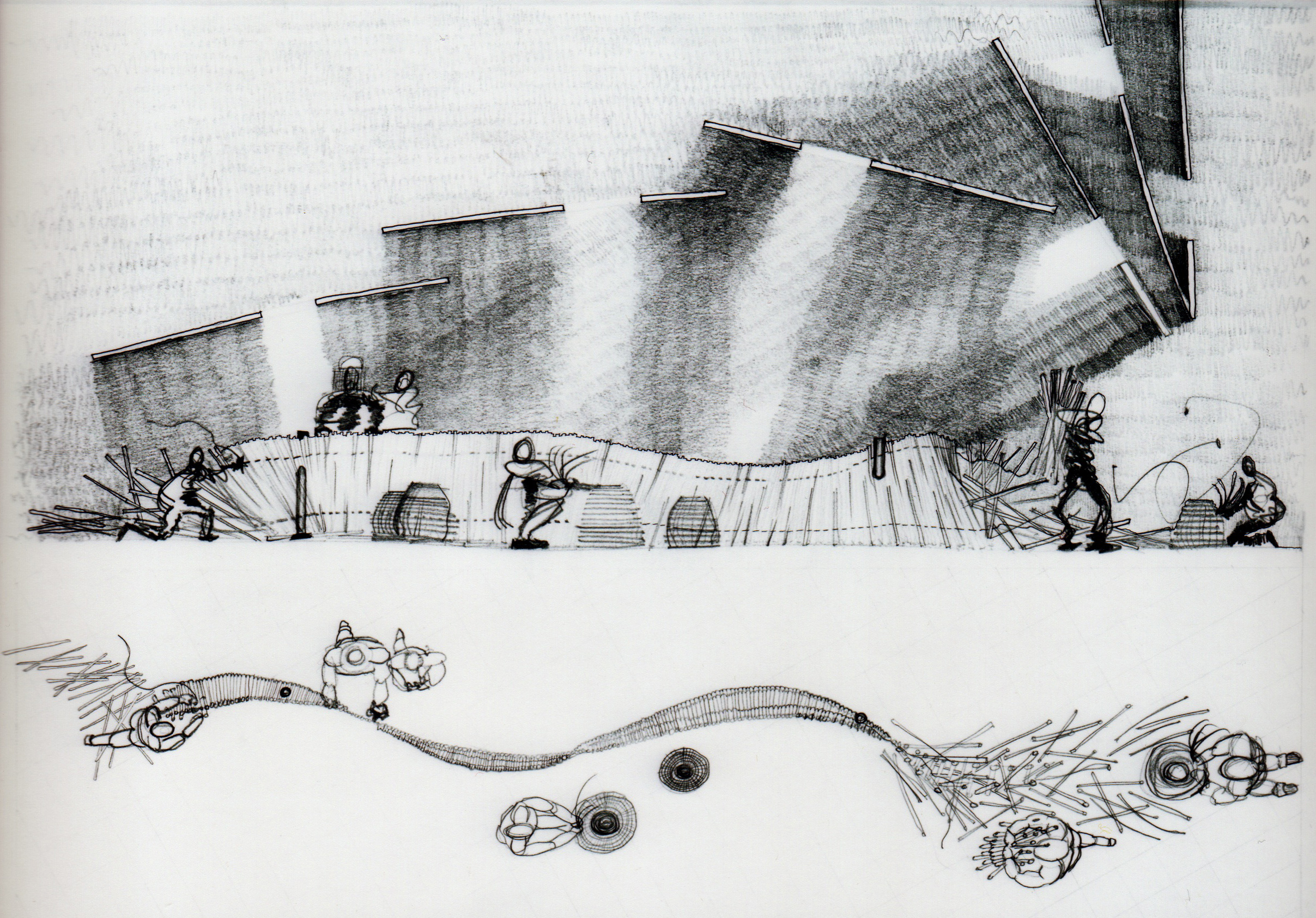
Skep Makers Weaving Shelter
This unusual space, which is able to shelter activity of weaving and the dry straw used for the construction of skeps. The motion of people under the skepmaker's awning is constantly changing, depending on where the dry straw is being unfurled. This space is seasonal and provides storage in the winter as well as a place for the equipment to be kept dry during the rainy season.

Railway workers by day/ Skepmakers by nights & weekends.
One of the activities at the Beekeeper's Institute is Skep Making. This is a historical activity that uses straw-dried in vertical matts and then removed from the matts once dried. The dry straw is then woven into basket like vessels for the introduction of a bee colony.
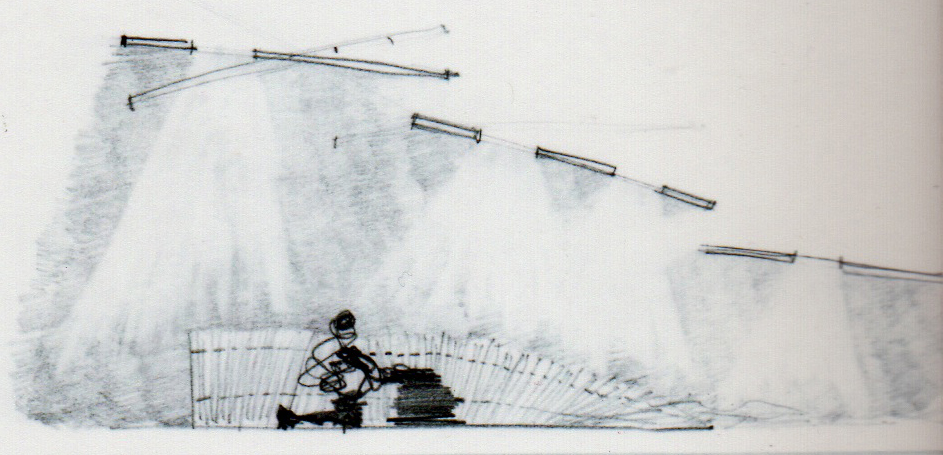
Showing Skep Maker under daylit shelter.

These Skep Makers maintain the railways for their day job.
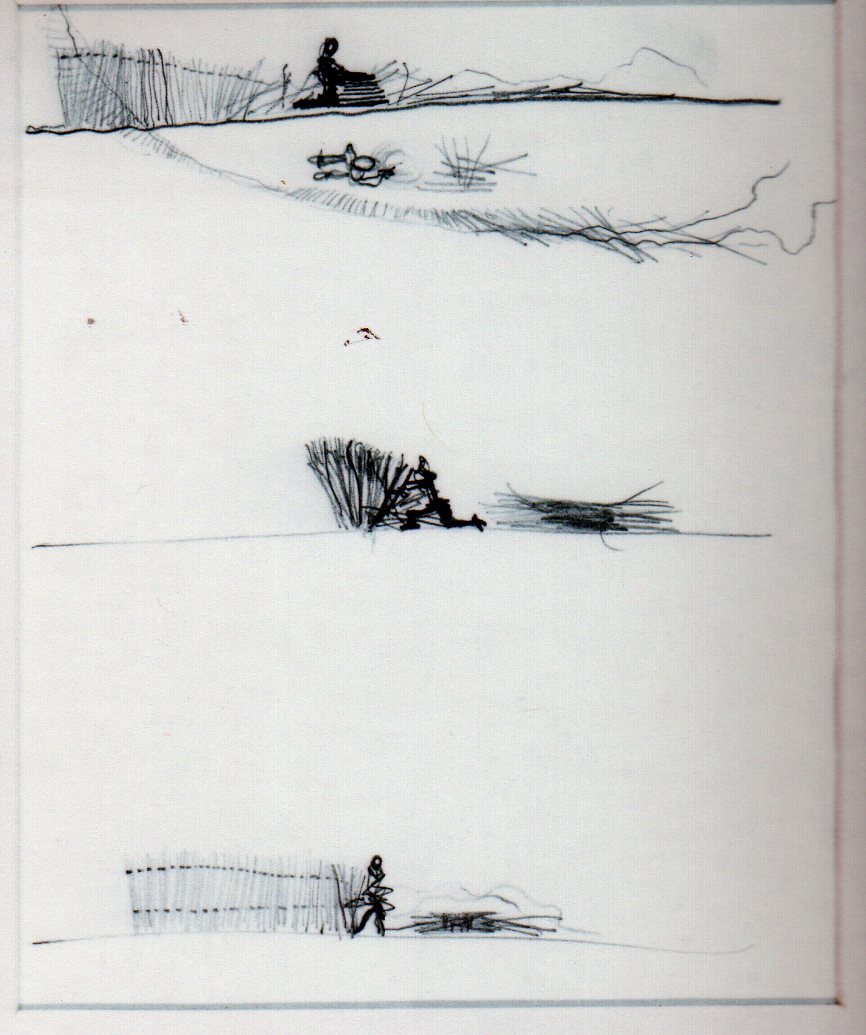
Sketches showing the weaving of straw mats in the Skep makers space.
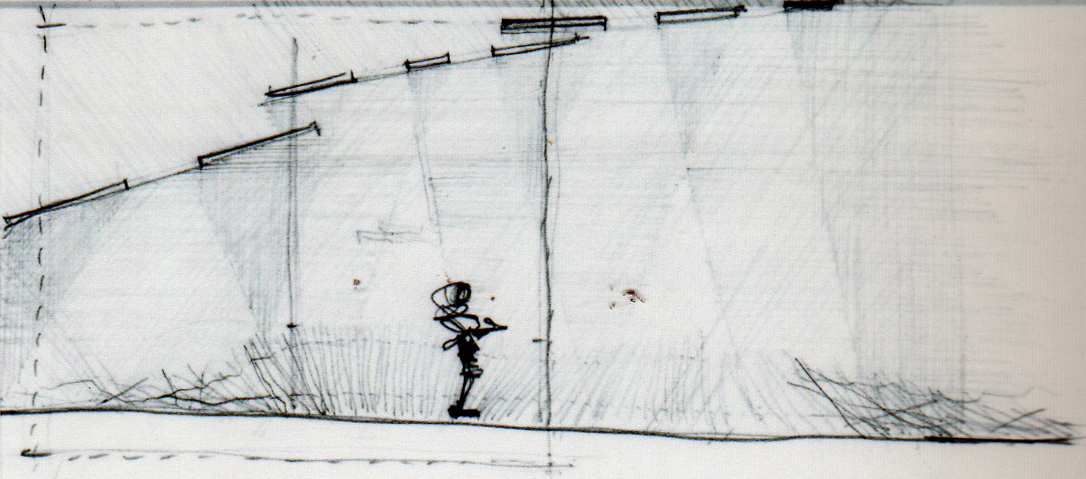
Sketch showing Skep Maker weaving a straw mat in the Skep makers space.
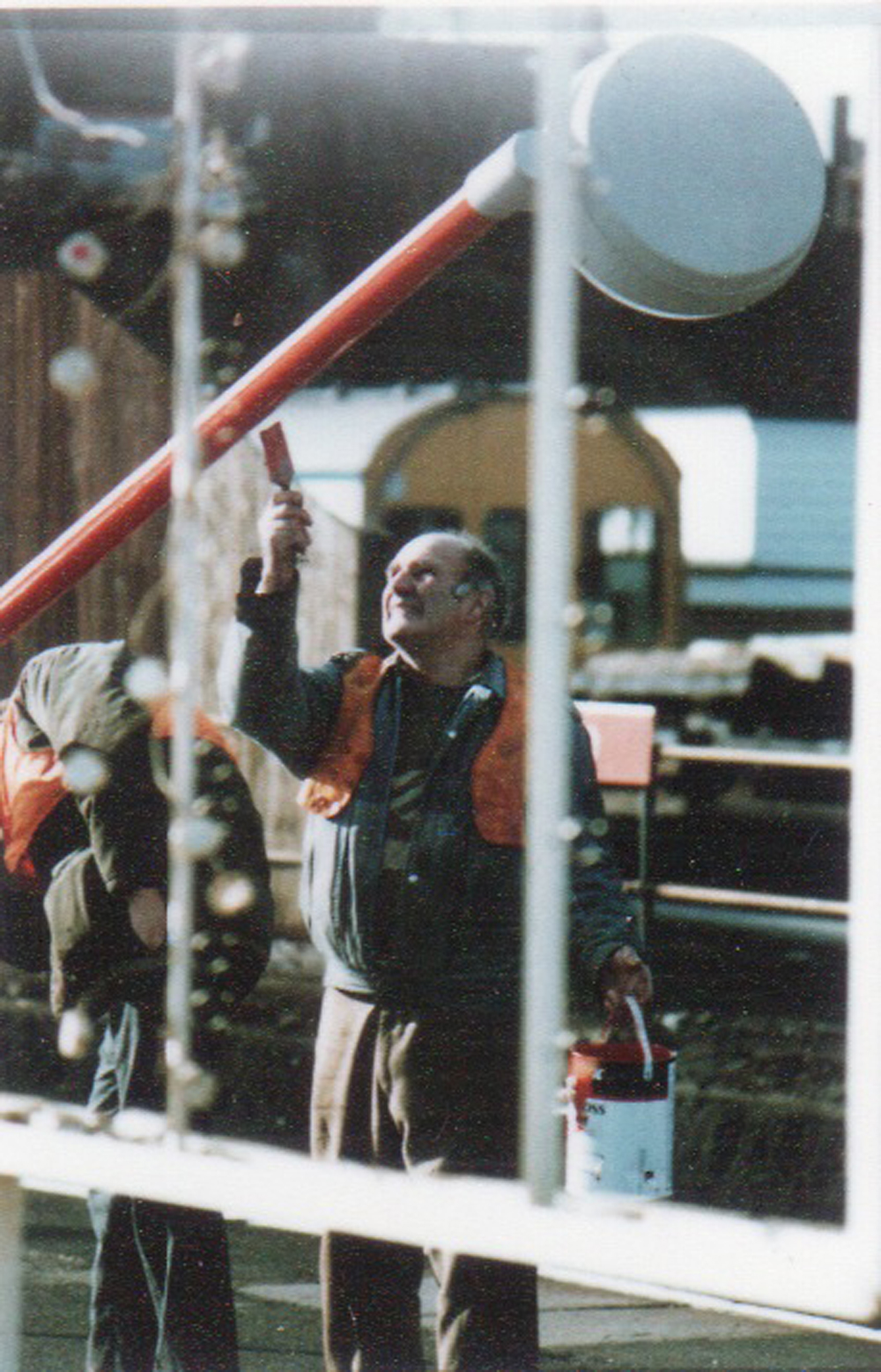
Railwaymen by day – Skep makers by night.
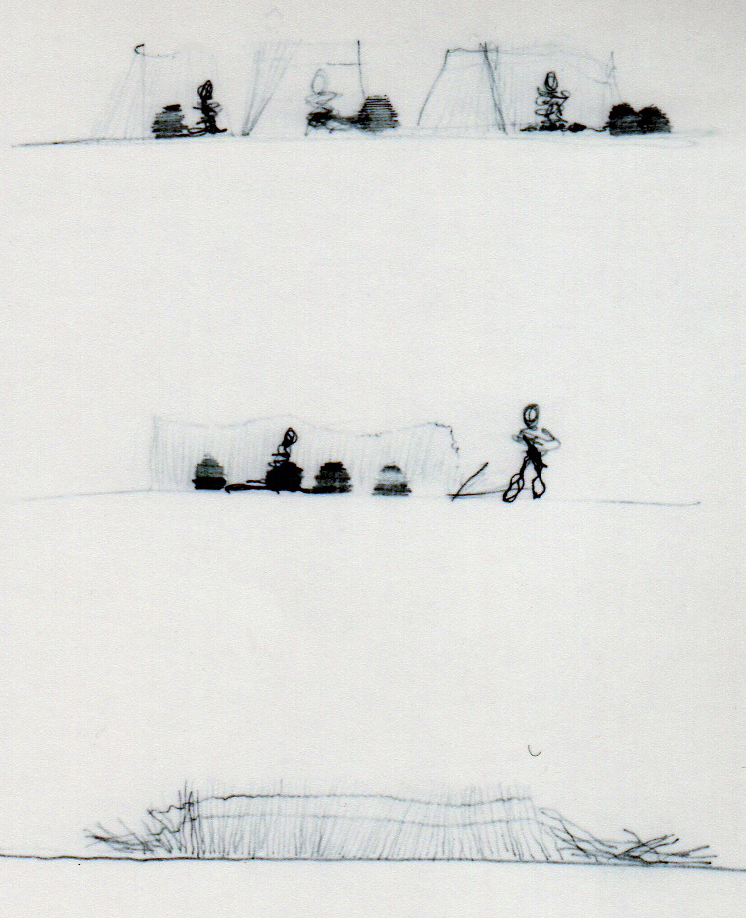
Sketch showing various straw mat weaving activities.

Stationers by day, Slide Librarians by Evenings and Weekends- a critical activity space at the Beekeepers Institute.



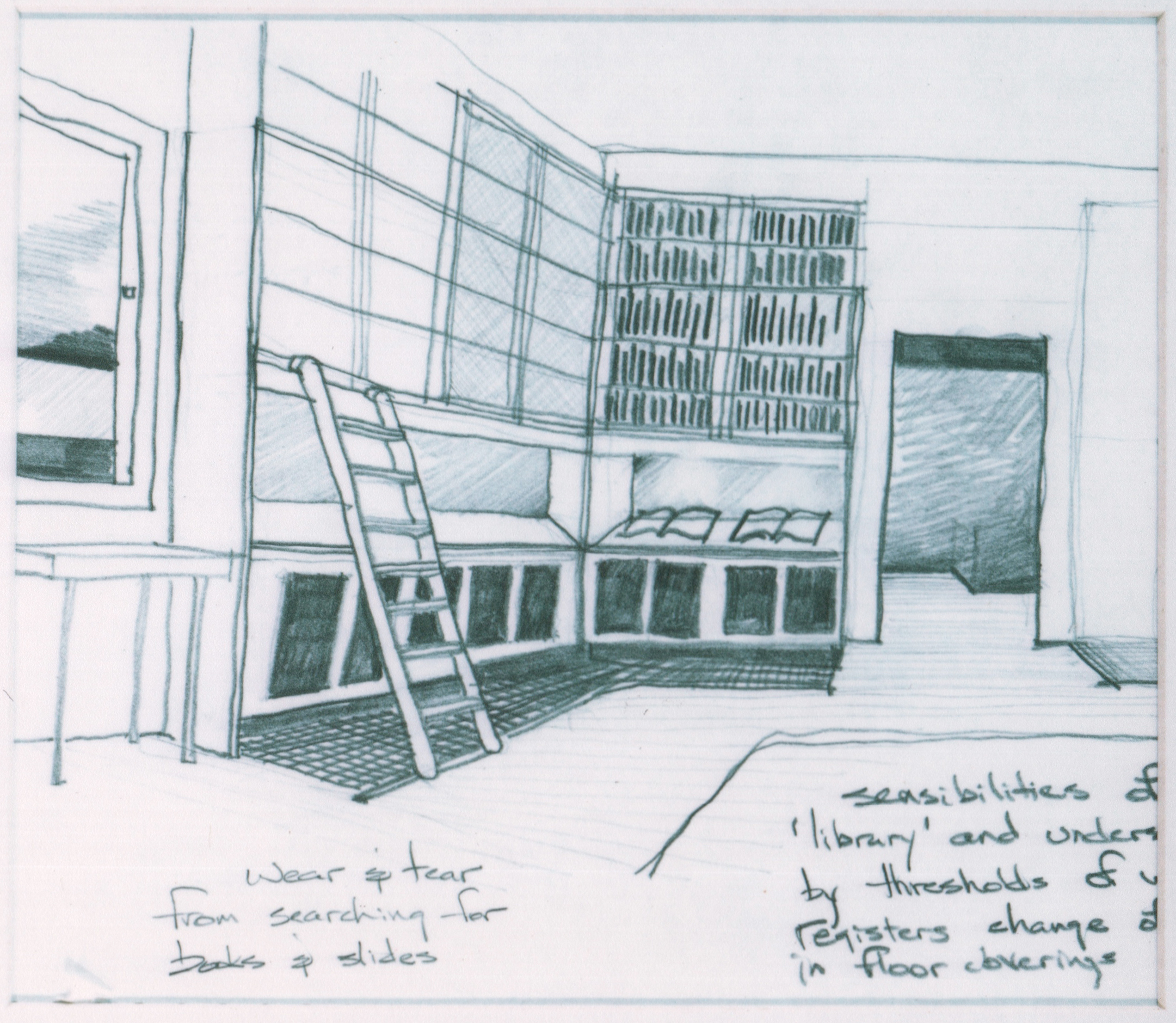
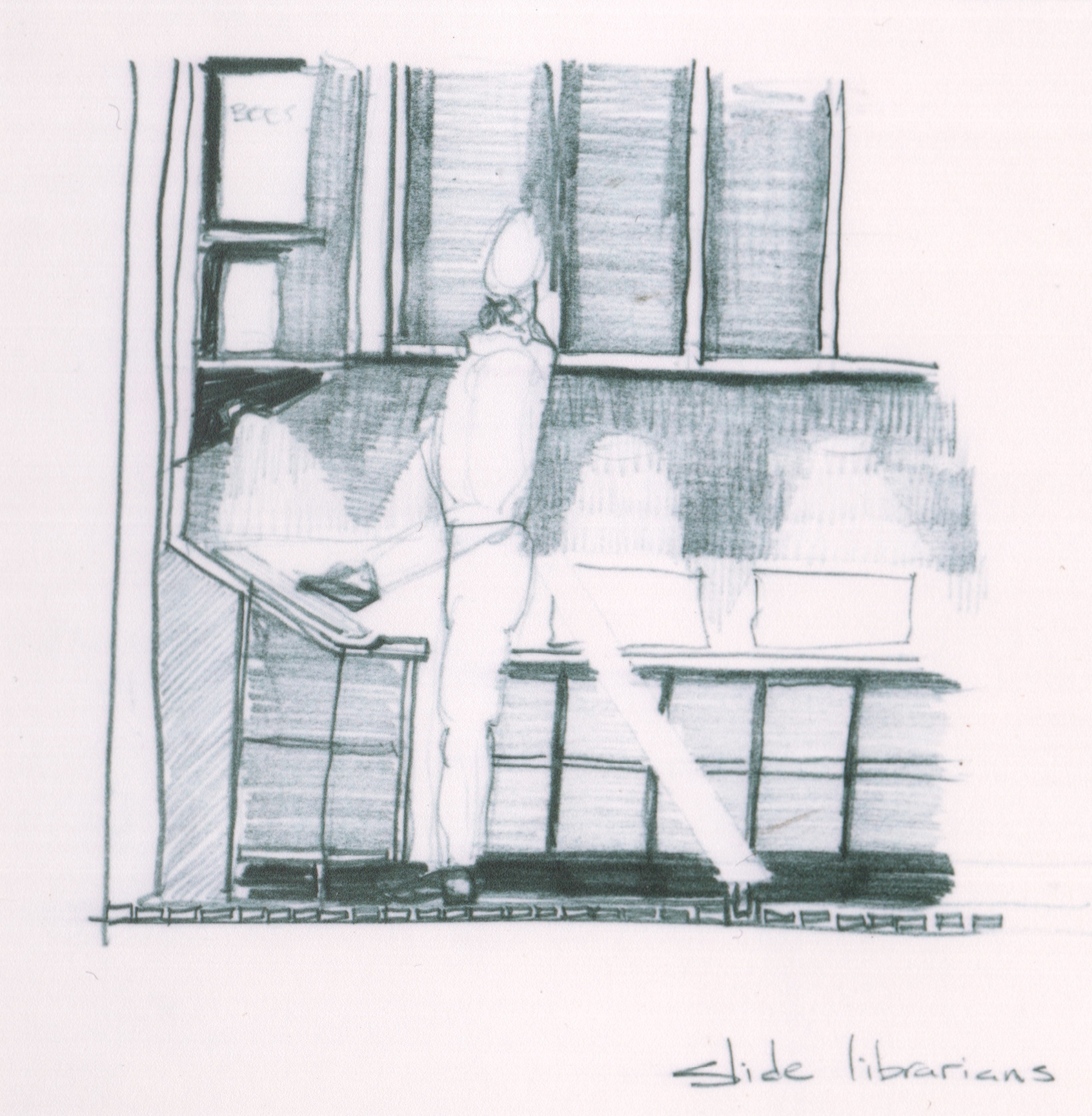




In this dark and space the entomologist learns how to communicate with the bees.

The entomologist's robotic, electronic bee performs a similar dance to the honey bee dance and communicates the distance, direction and type of forage.
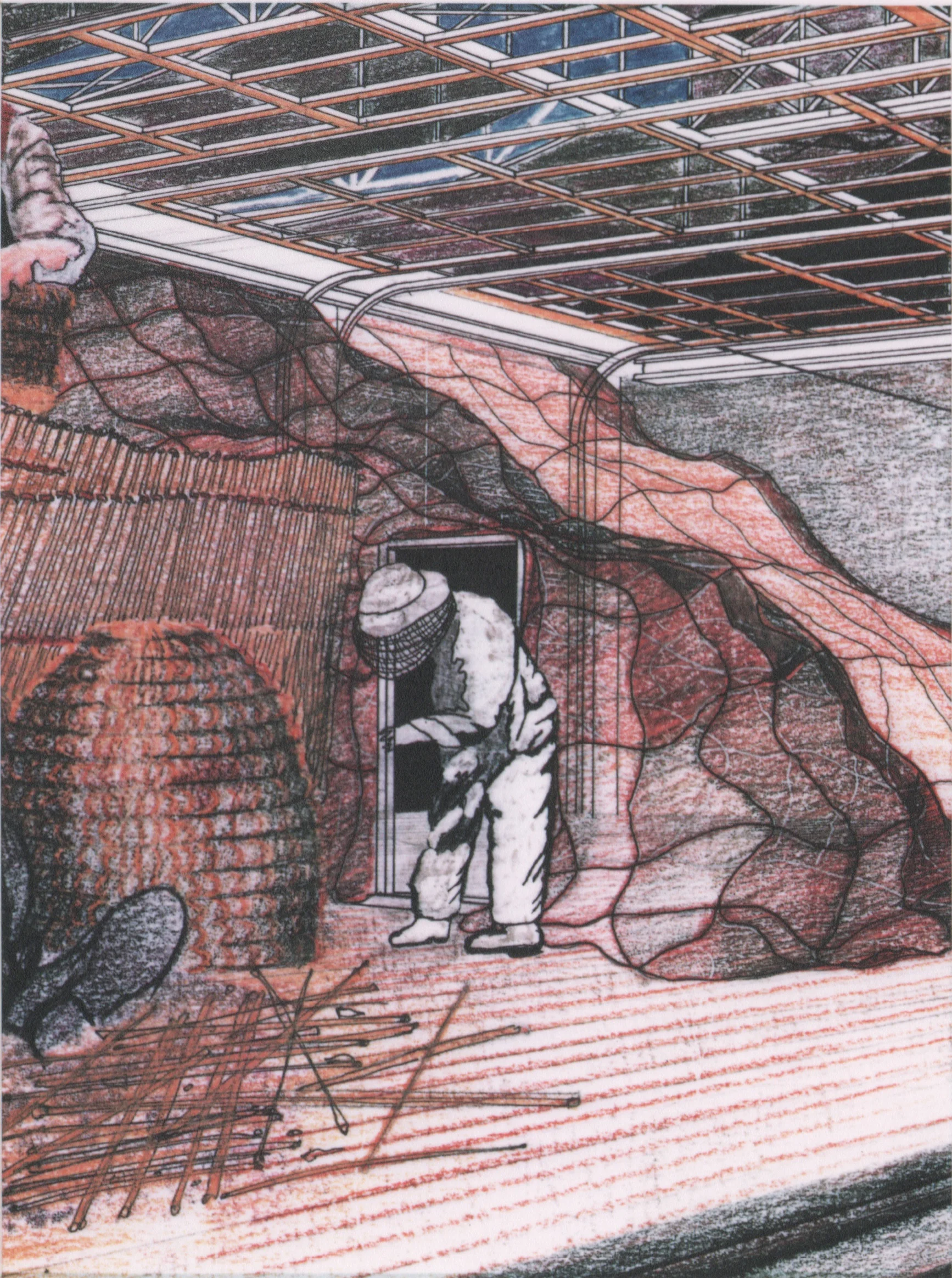
It is in this space that a colony of bees are temporarily housed in a space that is large enough to contain the entomologist and his equipment as well as the bees.

It is in this space that a colony of bees are temporarily housed in a space that is large enough to contain the entomologist and his equipment as well as the bees.
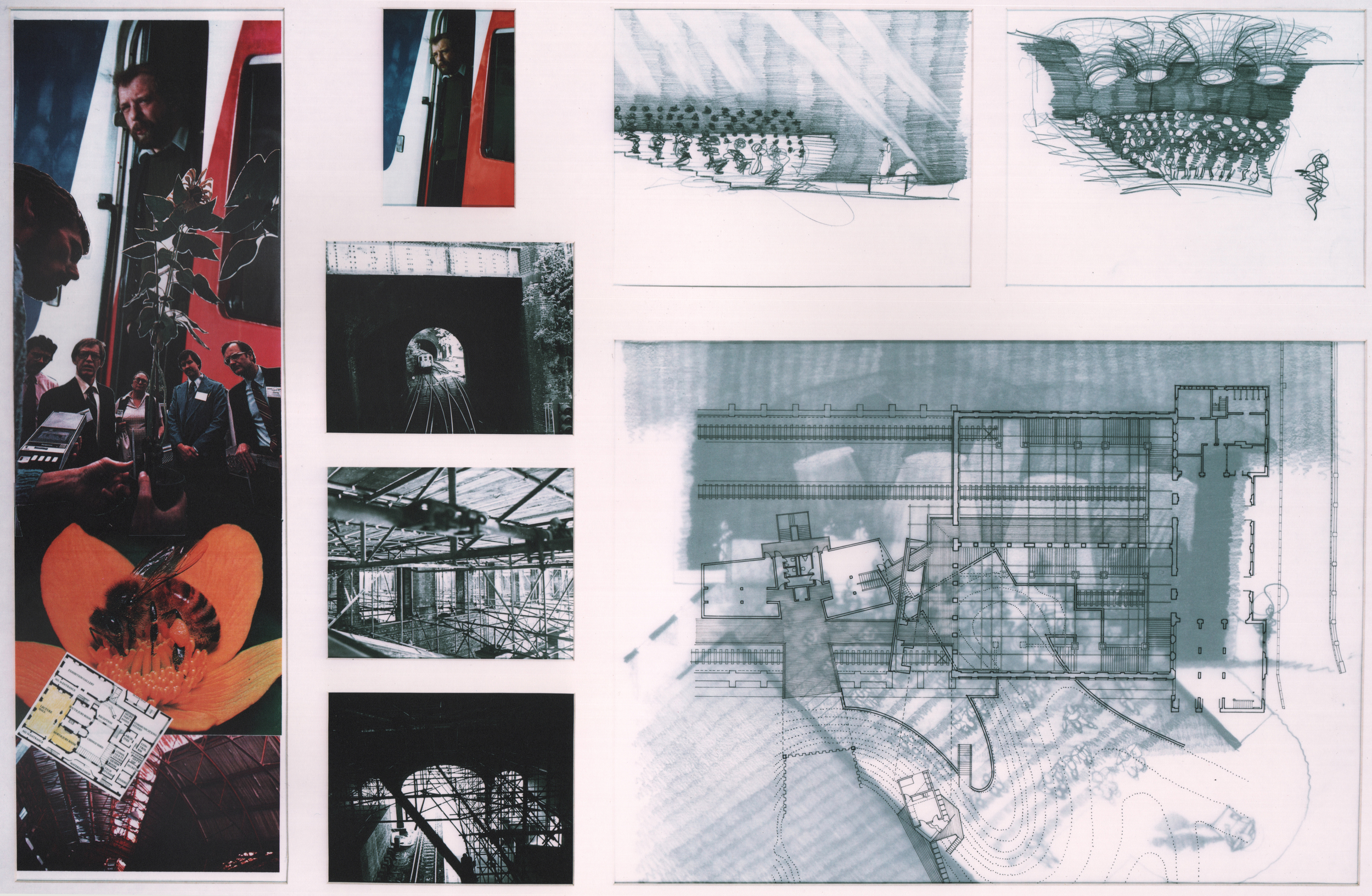
Lecturer at the institute teaches on plants that would not exist were it not for bees pollination.

Lecturer at the institute teaches on plants that would not exist were it not for bees pollination.

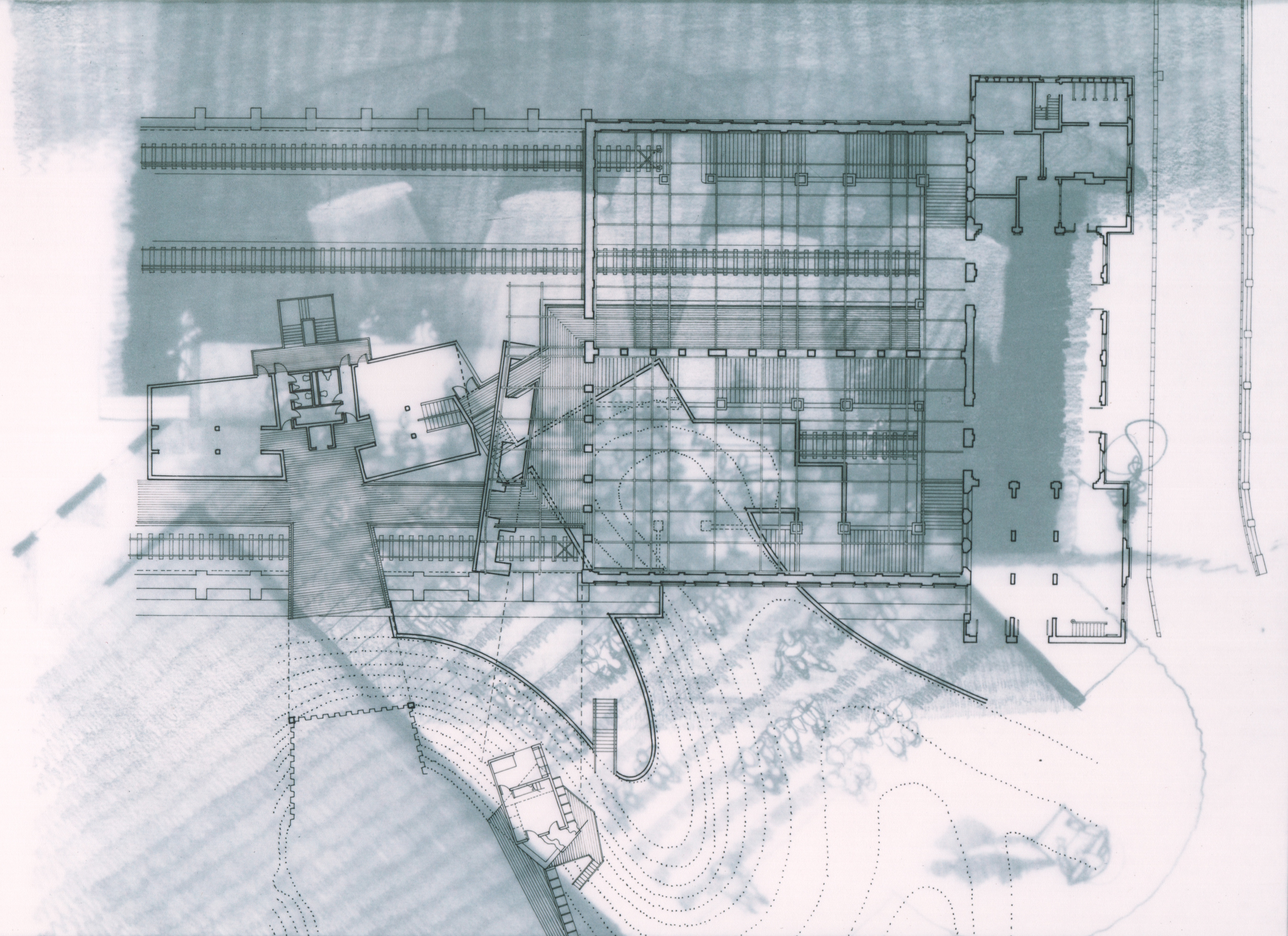
Lecturer at the institute teaches on plants that would not exist were it not for bees pollination.



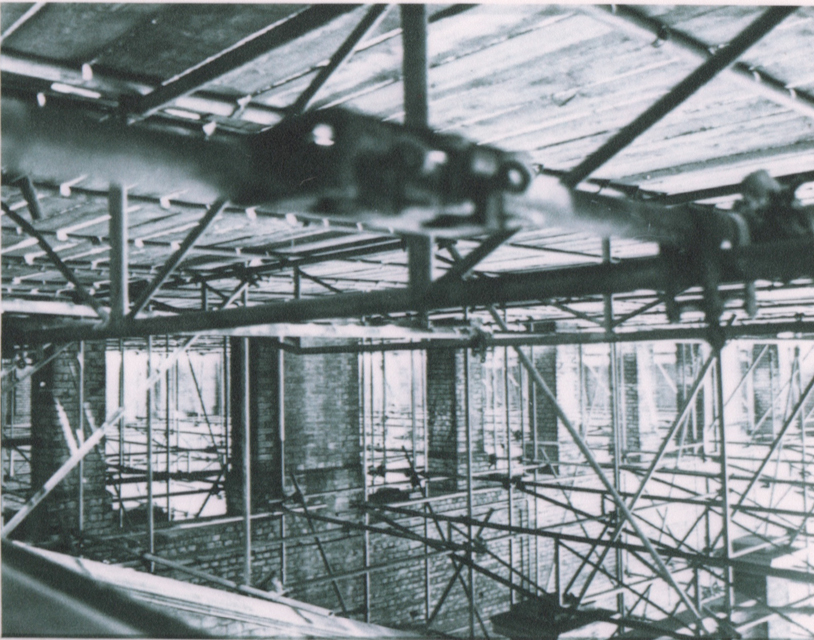

This space is for honey bee byproducts such as pollen, Royal Jelly, Beeswax, Honey and others...

This space is for honey bee byproducts such as pollen, Royal Jelly, Beeswax, Honey and others...

This space is for honey bee byproducts such as pollen, Royal Jelly, Beeswax, Honey and others...

This space is for honey bee byproducts such as pollen, Royal Jelly, Beeswax, Honey and others...

This space is for honey bee byproducts such as pollen, Royal Jelly, Beeswax, Honey and others...

This space is for honey bee byproducts such as pollen, Royal Jelly, Beeswax, Honey and others...

This space is for honey bee byproducts such as pollen, Royal Jelly, Beeswax, Honey and others...
